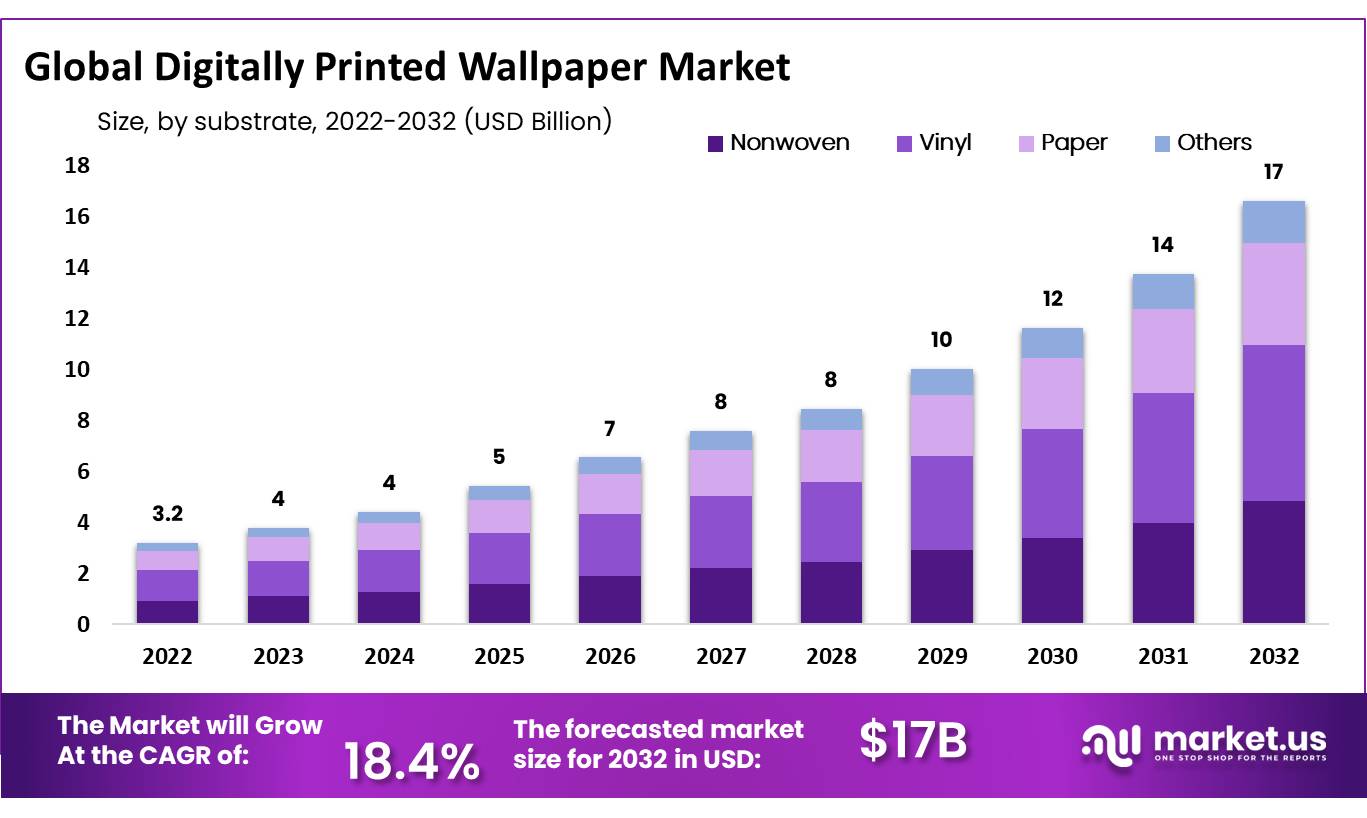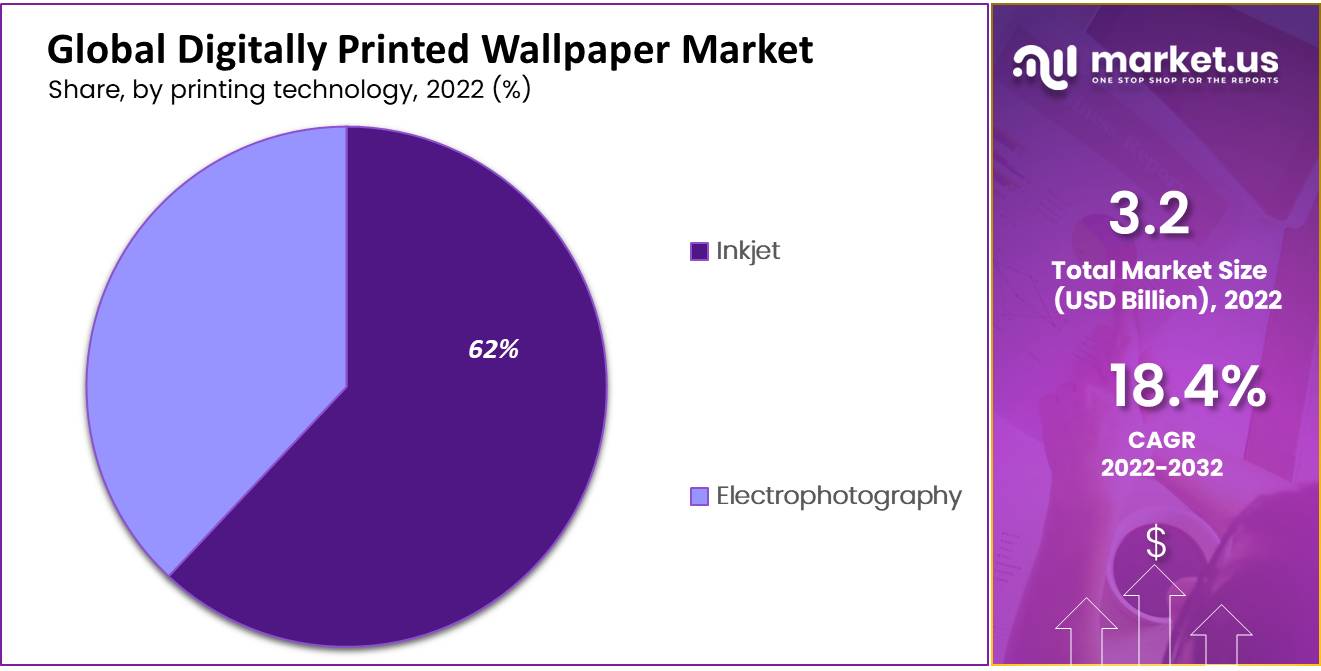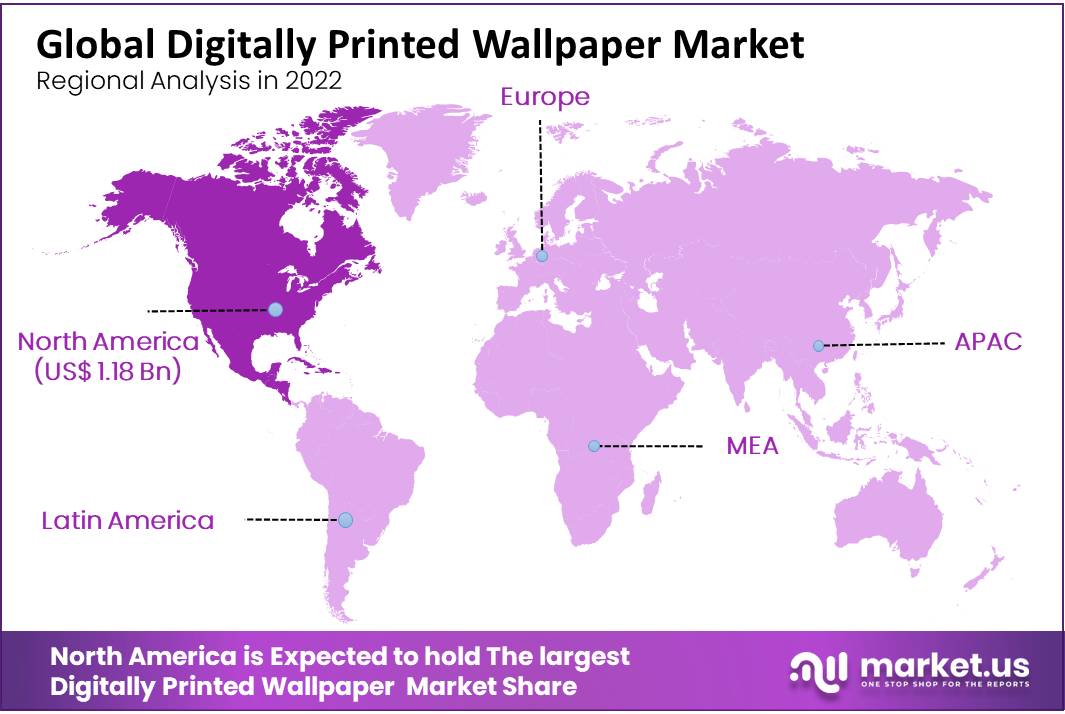Global Digitally Printed Wallpaper Market By Substrate (Nonwoven, Vinyl, Paper, and Others), By Printing Technology (Inkjet, and Electrophotography), By Type of Wallpaper (Wildlife, Scenic Beauty, Lifestyle, Architectural, Portrait, Wedding, Fashion, Abstract, and Others), By End User (Residential and Commercial) By Region and Companies - Industry Segment Outlook, Market Assessment, Competition Scenario, Trends, and Forecast 2023-2032
- Published date: Oct. 2023
- Report ID: 100075
- Number of Pages: 250
- Format:
- keyboard_arrow_up
Quick Navigation
Report Overview
In 2022, the Global Digitally Printed Wallpaper Market was valued at USD 3.2 billion and expected to grow USD 17 billion in 2032. Between 2023 and 2032, this market is estimated to register a CAGR of 18.4%.
As the demand for individualized home decor products rises, one area of the larger wallpaper market that is seeing significant development is the global market for digitally printed wallpaper. The term “digitally printed wallpaper” refers to a particular kind of wallpaper that can be customized and has a broad range of design options thanks to digital printing technology. The market has been driven by improvements in digital printing technology and the rising popularity of individualized home decor goods. Digitally printed wallpaper has developed into a desirable option for homeowners, interior designers, and commercial businesses equally thanks to the ability to create unique patterns and designs.

Key Takeaways
- Projected Market Growth: It is projected that the Digitally Printed Wallpaper Market will experience exponential growth by 2032, reaching USD 17 billion and recording an expected compound annual growth rate of 18.4% over its entire forecast period.
- Substrate Analysis: Vinyl is the most common substrate for digitally printed wallpaper, accounting for 37% of the market share, owing to its durability, waterproof properties, and ease of application.
- Printing Technology Analysis: Inkjet technology holds the dominant market share of 62%, known for its high-quality output, affordability, and adaptability, while electrophotography serves as another technique for creating digitally printed wallpaper, using digital laser printing for producing images on wallpaper material.
- Driving Forces: The market is driven primarily by technological advancements in digital printing technology, the growing desire for customizable home decor products with personalization capabilities, and an increase in eco-friendly and sustainable materials.
- Market Challenges: The industry faces significant market hurdles such as high initial investment costs, limited availability of eco-friendly materials and intense competition between well-established players which impedes entry of newcomers into the market.
- Growth Opportunities: Opportunities for growth exist in the form of a growing demand for customizable and personalized home decor products, advances in digital printing technology, increased focus on sustainability, and the potential of emerging markets, particularly in regions like Asia and the Middle East.
- Market Segments: The market is segmented based on substrates such as nonwoven, vinyl, paper, and others; printing technologies including inkjet and electrophotography; types of wallpaper like wildlife, scenic beauty, lifestyle, architectural, portrait, wedding, fashion, abstract, and others; and end-users, divided into residential and commercial segments.
- Regional Analysis: North America currently holds a dominant position in the global market, while Europe shows high demand and awareness for personalized home decor products. The Asia Pacific region is also experiencing significant growth in revenue generation, with a higher CAGR.
- Key Players: Some of the prominent players in the Digitally Printed Wallpaper Market include A S Creation Tapeten AG, Grandeco Wallfashion Group Belgium NV, Graham and Brown Ltd, MX Display Ltd, Flavor Paper, and others, who are continually innovating to cater to consumer demands and preferences.
Driving Factors
1. Advancements in digital printing technology
The development of digital printing technology has made it simpler and more affordable to create custom wallpaper patterns of the highest caliber. Smaller manufacturers and designers now have more opportunities to join the market, increasing competition and spurring innovation.
2. Customization and personalization
Digitally printed wallpaper gives consumers an outlet to show their individuality as they search more and more for distinctive and personalized goods. Custom wallpaper patterns can be made using digital printing to suit a variety of tastes and preferences.
3. Growing demand for eco-friendly products
Utilizing environmentally friendly ingredients and procedures, wallpaper can now be produced due to digital printing technology. As more customers become aware of their environmental impact and look for sustainable goods, this has grown to be a key market driver.
4. Increasing popularity of home decor and renovation
The market for home improvement and decor has been steadily expanding over the years, which has given wallpaper producers new possibilities. Digitally printed wallpaper is a popular option among both homeowners and interior designers because it provides a distinctive way to add individuality and style to a home.
Restraining Factors
1. High initial investment
It costs a lot to set up a digital printing factory for making wallpaper and to purchase the necessary hardware. This might limit the market entry of new competitors and the possibility for the growth of smaller businesses.
2. Limited availability of eco-friendly materials
Although there is a rising desire for environmentally friendly wallpaper options, there aren’t many sustainable and eco-friendly materials available. As a result, it might be harder for businesses to satisfy customer demand and the price of environmentally friendly options might go up.
3. High competition
There are many well-established competitors in the market for digitally produced wallpaper, making it very competitive. New competitors may find it challenging to capture market share and fight on both price and quality as a result.
Growth Opportunities
The global digitally printed wallpaper market presents several opportunities. This includes,
1. Growing Demand for Customizable and Personalized Home Decor Products
As consumers increasingly look for unique and personalized decor items, digitally printed wallpaper offers a convenient and customizable option. The ability to create custom designs and patterns with this type of paper is one of the key selling points of digitally printed wallpaper, expected to drive demand in this market.
2. Advances in digital printing technology
As digital printing technology continues to advance, it is expected to bring about further improvements in quality, speed, and efficiency. This can reduce production costs and boost output – making digitally printed wallpaper more accessible and affordable for consumers.
3. Increased Focus on Sustainability
As consumers become more environmentally aware, there is an increasing demand for eco-friendly and sustainable products. This presents digitally printed wallpaper manufacturers with the opportunity to develop new materials and production methods that are more sustainable and friendly to the planet.
4. Emerging Markets
The digitally printed wallpaper market is relatively young and there is significant potential for growth in emerging regions like Asia and the Middle East. As these regions continue to develop and urbanize, there will likely be increasing demand for personalized and customizable home decor options.
Trending Factors
1. Increased demand for personalization
Digitally printed wallpaper provides a variety of design choices and customization, which consumers are increasingly looking for in home decor options. Demand for digitally printed wallpaper is anticipated to continue to rise as a result of this development.
2. Focus on sustainability
The market for digitally printed wallpaper is no exception to the growing tendency toward environmentally friendly and sustainable goods. Manufacturers are progressively creating new eco-friendly and sustainable materials and manufacturing techniques.
3. Advances in technology
It is anticipated that the creation of new digital printing technologies will result in further enhancements to quality, productivity, and efficiency, increasing consumer access to and affordability of digitally printed wallpaper.
4. Increased availability of design software
The ease with which consumers can now create their unique wallpaper patterns using design software and online resources has boosted demand for digitally printed wallpaper.
Substrate Analysis
On the basis of the substrate, the market for digitally printed wallpaper is segmented into nonwoven, vinyl, paper, and others. The most common material for digitally produced wallpaper is vinyl. This substrate’s market share is 37%. Vinyl wall coverings are long-lasting, scratch-resistant, and simple to maintain. They can be used in high-moisture areas like restrooms and kitchens because they are also waterproof. Because they are dependable, simple to apply, and can conceal wall imperfections, nonwoven substrates are popular for digitally printed wallpaper. Additionally, breathable, nonwoven wallpapers can aid in preventing the development of mold and mildew. Traditional wallpaper options include paper substrates, which are well-liked due to their low cost and variety of patterns. Paper wallpapers, however, might not last as long as other materials and might be more difficult to maintain.
Printing Technology Analysis
By printing technologies, the market is segmented into inkjet, and electrophotography technologies. Inkjet segment is dominant with a market share of 62% in the overall market. The worldwide market for digitally printed wallpaper uses inkjet printing extensively because of its high-quality output, affordability, and adaptability. Using this technology, ink droplets are sprayed onto the wallpaper material’s surface to produce a high-resolution image with vivid hues and fine details. Another technique used in the creation of digitally printed wallpaper is electrophotography, also referred to as digital laser printing. In this method, a laser produces an electrostatic image on a drum that is later transferred onto the wallpaper substance by toner particles.

Note: Actual Numbers Might Vary In The Final Report
End-User Analysis
Based on end-user, the market for digitally printed wallpaper is divided into the commercial and residential segments. Among that, the commercial segment is dominant with a market share of about 60%. Commercially printed wallpaper is often employed to create custom designs that promote branding, enhance the ambiance and create spaces that stand out. Restaurants may utilize digitally printed wallpaper with food images to create an inviting ambiance for their patrons’ dining experiences. Hotels could similarly utilize scenic views as backdrops for creating relaxing atmospheres appealing to guests.
Residential digitally printed wallpaper is used to create unique and personalized spaces that showcase a homeowner’s personality and style. Homeowners have access to an array of designs, colors, and patterns and even create custom designs that complement their decor. The digitally printed wallpaper can also be employed for accent walls, murals, and other creative artwork that adds to the overall aesthetic and feel of a room.
Key Market Segments
Based on Substrate
- Nonwoven
- Vinyl
- Paper
- Others
Based on Printing Technology
- Inkjet
- Electrophotography
Based on Type of Wallpaper
- Wildlife
- Scenic Beauty
- Lifestyle
- Architectural
- Portrait
- Wedding
- Fashion
- Abstract
- Others
Based on End-User
- Residential
- Commercial
Regional Analysis
North America is the dominant region in the global digital printing wallpaper market. The market share of North America is 37%. Europe is the largest market with high demand and more awareness for personalized home décor products. These markets have a well-established customer base and supply chains. The Asia Pacific region is also seen significant growth in revenue generation throughout the forecast period. It grows with a higher CAGR.
The rest of the world, such as South America, the Middle East, and Africa, is expected to experience growth in the digitally printed wallpaper market due to rising consumer awareness and demand for personalized home decor products. Globally speaking, demand for these products will continue to increase due to a focus on personalization, sustainability, and technology across all regions; however, rates and extent of expansion may vary based on regional factors like consumer trends, economic conditions, and supply chain infrastructure.

Note: Actual Numbers Might Vary In The Final Report
Key Regions and Countries Covered in this Report:
- North America
- The US
- Canada
- Mexico
- Western Europe
- Germany
- France
- The UK
- Spain
- Italy
- Portugal
- Ireland
- Austria
- Switzerland
- Benelux
- Nordic
- Rest of Western Europe
- Eastern Europe
- Russia
- Poland
- The Czech Republic
- Greece
- Rest of Eastern Europe
- APAC
- China
- Japan
- South Korea
- India
- Australia & New Zealand
- Indonesia
- Malaysia
- Philippines
- Singapore
- Thailand
- Vietnam
- Rest of APAC
- Latin America
- Brazil
- Colombia
- Chile
- Argentina
- Costa Rica
- Rest of Latin America
- Middle East & Africa
- Algeria
- Egypt
- Israel
- Kuwait
- Nigeria
- Saudi Arabia
- South Africa
- Turkey
- United Arab Emirates
- Rest of MEA
Key Players Analysis
The global digitally printed wallpaper market is very uneven and has a number of players operating in the market. These key players are trying to find out innovative ways to serve customers and retain them for a longer period. The production methods and materials are used such as they will be done with minimum investment.
Market Key Players:
Listed below are some of the most prominent digitally printed wallpaper industry players.
- A S Creation Tapeten AG
- Grandeco Wallfashion Group Belgium NV
- Graham and Brown Ltd
- MX Display Ltd
- Flavor Paper
- Moonavoor Sisustus
- JOHNMARK LTD
- Glamora Srl
- Inkiostro Bianco PI
- Tecnografica
- Syndikat4
- DAISY JAMES
- ELITIS
- MINDTHEGAP
- YO2 Designs
- Arte International
- Astek
- Momentum Textiles & Wallcovering
- Londonart
- Other Key Players
Recent Developments
- In 2021: Muraspec Group introduced a new line of wallpaper 2021 that featured environmentally friendly choices made from recycled materials.
- In 2020: Flavor Paper and artist Wayne White teamed up to release a new brand of digitally printed wallpaper with his work on it.
Report Scope
Report Features Description Market Value (2022) USD 3.2 Bn Forecast Revenue (2032) USD 17 Bn CAGR (2023-2032) 18.4% Base Year for Estimation 2022 Historic Period 2016-2022 Forecast Period 2023-2032 Report Coverage Revenue Forecast, Market Dynamics, COVID-19 Impact, Competitive Landscape, Recent Developments Segments Covered By Substrate-Nonwoven, Vinyl, Paper, and Others; By Printing Technology-Inkjet, and Electrophotography; By Type of Wallpaper-Wildlife, Scenic Beauty, Lifestyle, Architectural, Portrait, Wedding, Fashion, Abstract, and Others; By End User-Residential and Commercial Regional Analysis North America – The US, Canada, & Mexico; Western Europe – Germany, France, The UK, Spain, Italy, Portugal, Ireland, Austria, Switzerland, Benelux, Nordic, & Rest of Western Europe; Eastern Europe – Russia, Poland, The Czech Republic, Greece, & Rest of Eastern Europe; APAC – China, Japan, South Korea, India, Australia & New Zealand, Indonesia, Malaysia, Philippines, Singapore, Thailand, Vietnam, & Rest of APAC; Latin America – Brazil, Colombia, Chile, Argentina, Costa Rica, & Rest of Latin America; Middle East & Africa – Algeria, Egypt, Israel, Kuwait, Nigeria, Saudi Arabia, South Africa, Turkey, United Arab Emirates, & Rest of MEA Competitive Landscape A S Creation Tapeten AG, Grandeco Wallfashion Group Belgium NV, Graham and Brown Ltd, MX Display Ltd, Flavor Paper, Moonavoor Sisustus, JOHNMARK LTD, Glamora Srl, Inkiostro Bianco PI, Tecnografica, Syndikat4, DAISY JAMES, ELITIS, MINDTHEGAP, YO2 Designs, Arte International, Astek, Momentum Textiles & Wallcovering, Londonart, and Other Key Players Customization Scope Customization for segments, region/country-level will be provided. Moreover, additional customization can be done based on the requirements. Purchase Options We have three licenses to opt for: Single User License, Multi-User License (Up to 5 Users), Corporate Use License (Unlimited User and Printable PDF) Frequently Asked Questions (FAQ)
What are digitally printed wallpaper?Digitally printed wallpapers refer to wallpapers that are printed using digital printing processes, such as inkjet and electrophotography.
What is the major substrate of digitally printed wallpaper?Vinyl is the most commonly used substrate in digitally printed wallpaper due to its high durability and easy maintenance, coupled with lower cost, which boosts the demand for vinyl wallpaper, mainly in emerging economies.
What are the factors driving the digitally printed wallpaper market?Key factors that are driving the digitally printed wallpaper market growth include a shift in consumer preferences towards wall covering and increasing DIY projects involving wallpapers are expected to drive the market. Furthermore, future predictions suggest that the wall-covering industry will continue to grow in size and significance, thus amplifying opportunities for the digitally printed wallpaper market
What are the benefits of digitally printed wallpaper?- The benefits of digitally printed wallpaper include:
- Wider range of designs and patterns
- Higher level of detail and accuracy
- More durable and long-lasting
- Easier to install
- More affordable than traditional wallpaper
How much does digitally printed wallpaper cost?The cost of digitally printed wallpaper varies depending on the size, design, and type of wallpaper. However, it is generally more affordable than traditional wallpaper.
 Digitally Printed Wallpaper MarketPublished date: Oct. 2023add_shopping_cartBuy Now get_appDownload Sample
Digitally Printed Wallpaper MarketPublished date: Oct. 2023add_shopping_cartBuy Now get_appDownload Sample - A S Creation Tapeten AG
- Grandeco Wallfashion Group Belgium NV
- Graham and Brown Ltd
- MX Display Ltd
- Flavor Paper
- Moonavoor Sisustus
- JOHNMARK LTD
- Glamora Srl
- Inkiostro Bianco PI
- Tecnografica
- Syndikat4
- DAISY JAMES
- ELITIS
- MINDTHEGAP
- YO2 Designs
- Arte International
- Astek
- Momentum Textiles & Wallcovering
- Londonart
- Other Key Players
- settingsSettings
Our Clients
| Single User $4,599 $3,499 USD / per unit save 24% | Multi User $5,999 $4,299 USD / per unit save 28% | Corporate User $7,299 $4,999 USD / per unit save 32% | |
|---|---|---|---|
| e-Access | |||
| Report Library Access | |||
| Data Set (Excel) | |||
| Company Profile Library Access | |||
| Interactive Dashboard | |||
| Free Custumization | No | up to 10 hrs work | up to 30 hrs work |
| Accessibility | 1 User | 2-5 User | Unlimited |
| Analyst Support | up to 20 hrs | up to 40 hrs | up to 50 hrs |
| Benefit | Up to 20% off on next purchase | Up to 25% off on next purchase | Up to 30% off on next purchase |
| Buy Now ($ 3,499) | Buy Now ($ 4,299) | Buy Now ($ 4,999) |















